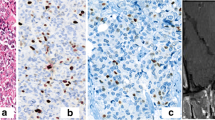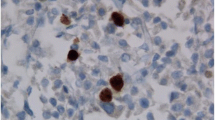Abstract
Ki-67 Labeling Index is an immunocytochemical marker of cell proliferation. The correlation of Ki-67 expression with pituitary adenomas recurrence has been investigated and is highly debated. Aim of this study was to evaluate whether Ki-67 correlates with recurrence even in patients with an apparently completely removed pituitary adenoma. We retrospectively reviewed the database of the Hypothalamic-Pituitary Disease Unit at the Catholic University of Rome, collected between 2003 and 2011. Inclusion criteria were: patients who underwent surgery at the Department of Neurosurgery with an apparently complete removal of a pituitary adenoma; Ki-67 histological evaluation by the same operator and values of <3 %. All patients underwent endocrine evaluation of the hypothalamic-pituitary function, ophthalmologic and neuro-radiological examinations, during the preoperative period and follow-up. Out of 490 patients recorded on the database of the Hypothalamic-Pituitary Disease Unit at the Catholic University of Rome, 191 cases met the inclusion criteria. Recurrence was observed in 49 cases (25.7 % of the patients who had undergone radical excision). Optional cut-off value was identified at Ki-67 values of 1.50 %. This was associated with worse disease-free survival time, even after correction for age at treatment, gender, positivity to p53, functional classification and Knosp grading. Ki-67 labeling index may be useful in postoperative management, even in patients who underwent radical PA removal. We suggest a Ki-67 cut-off value of 1.5 % to plan an adequate clinical follow-up.


Similar content being viewed by others
Abbreviations
- ACTH:
-
Adrenocorticotrophic hormone
- ACTH-oma:
-
ACTH secreting pituitary adenoma
- CI:
-
Confidence interval
- CS:
-
Cavernous sinus
- CSPA:
-
Cavernous sinus invasive pituitary adenoma
- FSH:
-
Follicle stimulating hormone
- GH:
-
Growth hormone
- GH-oma:
-
GH-secreting pituitary adenoma
- GSA:
-
Gonadotropic adenomas
- Ki-67 LI:
-
Ki-67 labeling index
- ICA:
-
Internal carotid artery
- LH:
-
Lutein hormone
- NFPA:
-
Non-functioning pituitary adenomas
- PA:
-
Pituitary adenoma
- PRL:
-
Prolactin
- PRL-oma:
-
PRL secreting pituitary adenoma
- RR:
-
Recurrence rate
- TSH:
-
Thyroid stimulating hormone
- TSH-oma:
-
TSH secreting pituitary adenoma
References
Losa M, Mortini P, Barzaghi R, Ribotto P, Terreni MR, Marzoli SB, Pieralli S, Giovanelli M (2008) Early results of surgery in patients with nonfunctioning pituitary adenoma and analysis of the risk of tumor recurrence. J Neurosurg 108(3):525–532
Mastronardi L, Guiducci A, Puzzilli F (2001) Lack of correlation between Ki-67 labelling index and tumor size of anterior pituitary adenomas. BMC Cancer 1:12
Salehi F, Agur A, Scheithauer BW, Lloyd RV, Cusimano M (2009) Ki-67 in pituitary neoplasms: a review. Part 1. Neurosurgery 65:429–437
Burger PC, Shibata T, Kleihues P (1986) The use of the monoclonal antibody Ki-67 in the identification of proliferating cells: application to surgical neuropathology. Am J Surg Pathol 10:611–617
Turner HE, Nagy Z, Gatter KC, Esiri MM, Wass JA, Harris AL (2000) Proliferation, bcl-2, expression and angiogenesis in pituitary adenomas: relationship to tumour behavior. Br J Cancer 82(8):1441–1445
Losa M, Franzin A, Mangili F, Terreni MR, Barzaghi R, Veglia F et al (2000) Proliferation index of nonfunctioning pituitary adenomas: correlation with clinical characteristics and longterm follow up results. Neurosurgery 47:1313–1318
Fukui S, Otani N, Nawashiro H, Yano A, Nomura N, Miyazawa T, Ohnuki A, Tsuzuki N, Katoh H, Ishihara S, Shima K (2002) Subcellular localization of basic fibroblast growth factor and fibroblast growth factor receptor 1 in pituitary adenomas. Brain Tumor Pathol 19:23–29
Hsu DW, Hakim F, Biller BM et al (1993) Significance of proliferating cell nuclear antigen index in predicting pituitary adenoma recurrence. J Neurosurg 78:753–761
Ramirez C, Cheng S, Vargas G, Asa S, Ezzat S, Gonzales B, Cabrera L, Guinto G, Mercado M (2012) Expression of Ki-67, PTTG1, FGFR4, and SSTR 2, 3 and 5 in nonfunctioning pituitary adenomas: a high throughput TMA, immunohistichemical study. J Clin Endocrinol Metabolism 97:1745–1751
Gejman R, Swearingen B, Hedly-Whyte T (2008) Role of Ki-67 proliferation index and p53 expression in predicting progression of pituitary adenomas. Hum Pathol 39:758–766
Matuyama J (2012) Ki-67 expression for predicting progression of postoperative residual pituitary adenomas: correlation with clinical variables. Neurol Med Chir 52:563–569
Noh TW, Jeong HJ, Lee TS, Kim SH, Lee EJ (2009) Predicting recurrence of nonfunctioning pituitary adenomas. J Clin Endocrinol Metab 94:4406–4413
Filippella M, Galland F, Kujas M, Young J, Faggiano A, Lombardi G, Colao A, Meduri G, Chanson P (2006) Pituitary tumor transforming gene (PTTG) expression correlates with the proliferative activity and recurrence status of pituitary adenomas: a clinical and immunohistochemical study. Clin Endocrinol 65(4):536–543
Peak K, Kim SH, Song SH, Choi SW, Koh HS, Youm JY, Kim Y (2005) Clinical significance of Ki 67 labeling index in pituitary macroadenoma. J Korean Med Sci 20:489–494
Righi A, Agati P, Sisto A, Frank G, Faustini-Fustini M, Agati R, Mazzatenta D, Farnedi A, Menetti F, Marucci G, Foschini MP (2012) A classification tree approach for pituitary adenomas. Hum Pathol 43:1627–1637
Abe T, Sanno N, Osamura YR, Matsumoto K (1997) Proliferativepotential in pituitary adenomas: measurement by monoclonal antibody MIB-1. Acta Neurochirur. 139:613–618
Mastronardi L, Guiducci A, Spera C, Puzzili F, Liberati F, Maira G (1999) Ki-67 labelling index and invasiveness among anterior pituitary adenomas: analysis of 103 cases using the MIB-1 monoclonal antibody. J Clin Pathol 52:107–111
Schreiber S, Saeger W, Ludecke DK (1999) Proliferation markers in different typer of clinically non-secreting pituitary adenomas. Pituitary 1:213–220
Pizarro CB, Oliveira MC, Coutinho LB, Ferreira NP (2004) Measurement of Ki-67 antigen in 159 pituitary adenomas using the MIB-1 monoclonal antibody. Braz J Med Biol Res 37:235–243
Rishi A, Sharma MC, Sarkar C, Jain D, Singh M, Mahapatra AK, Mehta VS, Das TK (2010) A clinicopathological and immunohistochemical study of clinically non-functioning pituitary adenomas: a single institutional experience. Neurol India 58:418–423
Wierinckx A, Auger C, Devauchelle P, Reynaud A, Chevallier P, Jan M, Perrin G, Fevre-Montage M, Rey C, Figarella-Branger D, Raverot G, Belin MF, Lachuer J, Trouillas J (2007) A diagnostic marker set for invasion, proliferation, and aggressiveness of prolactin pituitary tumors endocrine-related. Cancer 14:887–900
Jaffrain-Rea ML, Di Stefano D, Minniti G, Esposito V, Bultrini A, Ferretti E, Santoro A, Faticanti Scucchi L, Gulino A, Cantore G (2002) A critical reappraisal of MIB-1 labeling index significance in a large series of pituitary tumors: secreting versus non-secreting adenomas. Endocrine Related Cancer 9:103–113
Hentschel SJ, McCutcheon E, Moore W, Durity FA (2003) P53 and MIB-1 immunohistochemistry as predictors of the clinical behavior of nonfunctioning pituitary adenomas. Can J Neurol Sci 30:215–219
Dubois S, Guyetant S, Menei P, Rodien P, Fillouz F, Vielle B, Rohmer V (2007) Relevance of Ki-67 and prognostic factors for recurrence/progression of gonadotropic adenomas after first surgery. Eur J Endocrinol 157:141–147
Chacko G, Chacko AG, Kovacs K, Scheithauer BW, Mani S, Muliyil JP, Seshadri MS (2010) The clinical significance of MIB-1 index in pituitary adenomas. Pituitary 13:337–344
Ma W, Ikeda H, Yoshimoto T (2002) Clinicopathologic study of 123 cases of prolactin-secreting pituitary adenomas with special reference to multihormone production and clonality of the adenomas. Cancer 95:258–265
Mete O, Ezzat S, Asa S (2012) Biomarkers of aggressive pituitary adenomas. J Mol Endocrinol 49:R69–R78
Knosp E, Steiner E, Kitz K, Matula C (1993) Pituitary adenomas with invasion of the cavernous sinus space: a magnetic resonance imaging classification compared with surgical findings. Neurosurgery 33:610–618
Ferrante E, Ferraroni M, Castrignano T, Menicatti L, Anagni M, Reimondo G, Del Monte P, Bernasconi D, Loli P, Faustini-Fustini M, Borretta G, Terzolo M, Losa M, Morabito A, Spada A, Beck-Peccoz P, Lania AG (2006) Non-functioning pituitary adenoma database: a useful resource to improve the clinical management of pituitary tumors. Eur J Endocrinol 155:823–829
Brochier S, Galland F, Kujas M, Parker F, Gaillard S, Raftopoulos C, Young J, Alexopoulou O, Maiter D, Chanson P (2010) Factors predicting relapse of nonfunctioning pituitary macroadenomas after neurosurgery: a study of 142 patients. Eur J Endocrinol 163:193–200
Roelfsema F, Biermasz NR, Pereira AM (2012) Clinical factors involved in the recurrence of pituitary adenomas after surgical remission: a structured review and meta-analysis. Pituitary 15:71–83
Hosmer DW, Lemeshow S (1989) Applied logistic regression. Wiley, New York
Fusco A, Zatelli MC, Bianchi A, Cimino V, Tilaro L, Angelini F, Lauriola L, Vellone V, Doglietto F, Ambrosio MR, Maira G, Giustina A, degli Uberti EC, Pontecorvi A, De Marinis L (2008) Prognostic significance of the Ki-67 labeling index in growth hormone-secreting pituitary adenomas. J Clin Endocrinol Metab 93:2746–2750
Delgrange E, Trouillas J, Maiter D, Donckier J, Tourniaire J (1997) Sex-related difference in the growth of prolactinomas: a clinical and proliferation marker study. J Clin Endocrinol Metab 82:2102–2107
Honegger J, Prettin C, Feuerhake F, Petrick M, Schulte-Monting J, Reincke M (2003) Expression of Ki-67 antigen in nonfunctioning pituitary adenomas: correlation with growth velocity and invasiveness. J Neurosurg 99:674–679
Ekramullah SM, Saitoh Y, Arita N, Ohnishi T, Hayakawa T (1996) The correlation of Ki-67 staining indices with tumor doubling times in regrowing non-functioning pituitary adenomas. Acta Neurochir 138:1449–1455
Tanaka Y, Hongo K, Tada T, Sakai K, Kakizawa Y, Kobayashi S (2003) Growth pattern and rate in residual nonfunctioning pituitary adenomas and carcinomas: correlations among tumor volume doubling time, patient age, and MIB-1 index. J Neurosurg 98:359–365
Zhao D, Tomono Y, Nose T (1999) Expression of P27kip1 and Ki- 67 in pituitary adenomas: an investigation of marker of adenoma invasiveness. Acta Neurochir 141:187–192
Botelho CH, Magalhães AV, Mello PA, Schmitt FC, Casulari LA (2006) Expression of p53, Ki-67 and c-erb B2 in growth hormone–and/or prolactin—secreting pituitary adenomas. Arq Neuropsiquiatr 64:60–66
Nakabayashi H, Sunada I, Hara M (2001) Immunohistochemical analysis of cell cycle-related proteins, apoptosis, and proliferation in pituitary adenomas. J Histochem Cytochem 49:1193–1194
Acknowledgments
This research did not receive any specific grant from any funding agency in the public, commercial or not-for-profit sector.
Conflict of interest
The authors declare that there is no conflict of interest that could be perceived as prejudicing the impartiality of the research reported.
Author information
Authors and Affiliations
Corresponding author
Rights and permissions
About this article
Cite this article
Chiloiro, S., Bianchi, A., Doglietto, F. et al. Radically resected pituitary adenomas: prognostic role of Ki 67 labeling index in a monocentric retrospective series and literature review. Pituitary 17, 267–276 (2014). https://doi.org/10.1007/s11102-013-0500-6
Published:
Issue Date:
DOI: https://doi.org/10.1007/s11102-013-0500-6




